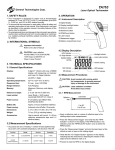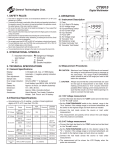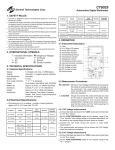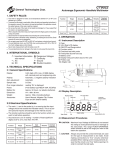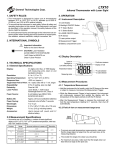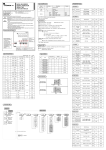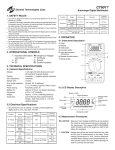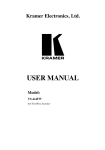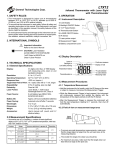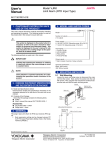Download User`s Manual (PDF 241K) - General Technologies Corp.
Transcript
TA105 General Technologies Corp. Laser Optical Tachometer 1. SAFETY RULES 4. OPERATION • This Instrument is designed for indoor use at temperatures between 32°F to 122°F (0°C to 50°C), altitudes up to 6500 ft. (2,000 m), and 10% to 90% relative humidity. • To ensure that the instrument is used safely, follow all safety and operating instructions in this manual. If the instrument is not used as described in this operation manual, the safety features of this device might be impaired. • To avoid personal injuries and damage to the instrument use extreme caution when working around hot or moving objects or machinery like: radiators, exhaust manifolds, catalytic converters, drive belts, fly wheels, etc. 4.1 Instrument Description 1) Laser output 2) Laser warning symbol 3) Measurement button 4) Function switch 5) Memory button 6) Digital display 7) Battery compartment cover 2. INTERNATIONAL SYMBOLS � Important information Refer to the User’s Manual 4.2 Display Description CAUTION: Laser Radiation AVOID DIRECT EYE EXPOSURE 1mW Output at 630-670 nm Class II Laser Product 3. TECHNICAL SPECIFICATIONS 3.1 General Specifications Display: 5 digits 0.7” (16mm) LCD, Max. of 99999 display, with measuring unit indicator and Laser On Target indicator Resolution: Operating Temperature: Response time: Range Selection: Memory: ±(0.05%+1 Digit) 32°F to 122°F (0°C to 50°C) 0.5 sec. (over 120 RPM) Auto Ranging Max. Value, Min. Value and Last Value stored automatically in memory 2” to 20” (50 mm to 500 mm) Laser Diode, < 1mW output wavelength 630-670 nm, Class II Distance to target: Laser Pointer: Power Source: 4 x 1.5 V type AA/UM3 or equivalent Battery life: Dimensions: Weight: Approx. 5 hours.(w/alkaline batteries) 6.3”x 2.8”x 1.5” (160 x 72x 37 mm) 6.96 oz. (200 g) with battery. Accesories: Soft Pouch, 23.5” (600 mm) long reflective tape,4 x 1.5 V alkaline battery, and User’s Manual 4.3 Measurement Procedures � CAUTION: Avoid contact with moving and hot components, to prevent personal injury or damage to the instrument. � CAUTION: Laser Radiation is emitted Avoid direct eye contact 4.3.1 RPM Measurement 3.2 Measurement Specifications • Accuracies are ±(% of reading + number of least significant digits) at 23°C ±5°C ambient temperature, with less than 75% RH. Function Range Acuracy 2.5 to 999.9 RPM RPM 0.1 RPM ±(0.05%+1 Digit) 1000 to 99,999 RPM TOT (total revolutions) Resolution 1 to 99,999 RPM 1 RPM ±(0.05%+1 Digit) 1 RPM • Apply a reflective mark or a piece of reflective tape to the rotating object under measurement. • Slide the function switch to the “RPM” position • Press the measurement button and aim the light beam to the reflective mark or tape on the rotating object. • Verify that the “On Target Indicator“ appears on the display, indicating that the instrument is detecting the rotation of the object and the reflective mark on it. • Proceed to read the RPM on the digital display. 4.3.2 TOT (Total revolutions) function 5. MAINTENANCE • Apply a reflective mark or a piece of reflective tape to the rotating object under measurement. 5.1 Battery Replacement • Slide the function switch to the “TOT” position • Press the measurement button and aim the light beam to the reflective mark or tape on the rotating object. • When the battery is low and needs to be replaced, the “Low Bat- • Verify that the “On Target Indicator“ appears on the display, indicating that the instrument is detecting the rotation of the object and the reflective mark on it. • Proceed to read the total revolutions on the digital display. 4.3.3 Reflective marks • Cut a 1/2” length of the reflective tape provided, peel off the back to expose the adhesive, and attach it to the rotating part or shaft to measure, observing the following recommendations: - The non-reflective area must always be smaller that the reflective piece of tape. - If the object or shaft to measure is reflective, it must first be covered with a black tape or painted black before attaching the reflective tape. - Before applying the tape ensure that the surface is clean and smooth 4.3.4 Very low RPM measurements The response time will vary with the rotational speed being measured. Therefore when measuring very slow rotating parts, it may be advantageous to follow the procedure below to increase the update rate of the measurement: • Depending on the size of the rotating object or shaft, attach multiples reflective marks, evenly spaced along its circumference. • Proceed to measure RPM as described in 4.3.1, and divide the reading by the number of reflective marks, in order to obtain the correct RPM. tery Warning” symbol will appear on the lower left hand side of the display. • To replace the battery, remove the screw and open the battery compartment cover (located at the back of the unit), and remove the battery. • Replace with 4 x 1.5 V type AA/UM3 or equivalent observing the proper polarity of each battery as indicated at the bottom of the battery compartment. • Close the battery cover, and replace the screw. 5.2 Cleaning 5.2.1 Lens cleaning Debris or dirt on the lens may cause obstruction and impede the working of the tachometer. If this occurs, either wipe the lens with a Q-tip (moistened with water only) or blow off the loose particles with clean compressed air. Do not use solvent on the lenses, as it may become damage. 5.2.2 Exterior cleaning Periodically wipe the case with a soft damp cloth and mild household cleanser. Do not use abrasives or solvents. Ensure that no water gets inside the instrument to prevent possible shorts and damage. 6. WARRANTY One year limited warranty, excluding batteries and fuses. For details see Standard Warranty Information on our web page or you may request a printed copy. 4.4 Other Functions 4.4.1 Display Hold • The instrument will automatically hold the last reading immediately after the “On Target Indicator” on the display turns off, and hold it while the “Measurement button” is pressed. 4.4.2 MEM function In every measuring cycle (pressing the measuring button, obtaining a reading, and then releasing the button), the instrument will automatically store in its internal memory the Maximum, Minimum and Last value. To retrieve the values in memory follow the procedure described below: • With the instrument off press and hold down the “MEM” button to display the Maximum value stored in memory. Display screens will alternate between “UP” (maximum) and the stored maximum reading. Note the value and release the “MEM” button. • Pressing and holding again the “MEM” button will display the Minimum value stored in memory. Display screens will alternate between “dn” (minimum) and the stored minimum reading. Note the value and release the “MEM” button. • Pressing and holding again the “MEM” button will display the last reading value stored in memory. Display screens will alternate between “LA” (Last reading) and the stored last reading value. Note the value and release the “MEM” button. This memory retrieval cycle will keep repeating in the order detailed above. Notes: The values stored in memory will be retained until a new measurement cycle is performed. Removing the batteries, or low batteries will cause all values stored in memory to be erased. General Technologies Corp. #121 - 7350 72nd Street Delta, BC Canada V4G 1H9 Tel.: (604) 952-6699 Fax: (604) 952-6690 www.generaltechnologies.net © Copyright 2004 General Technologies


